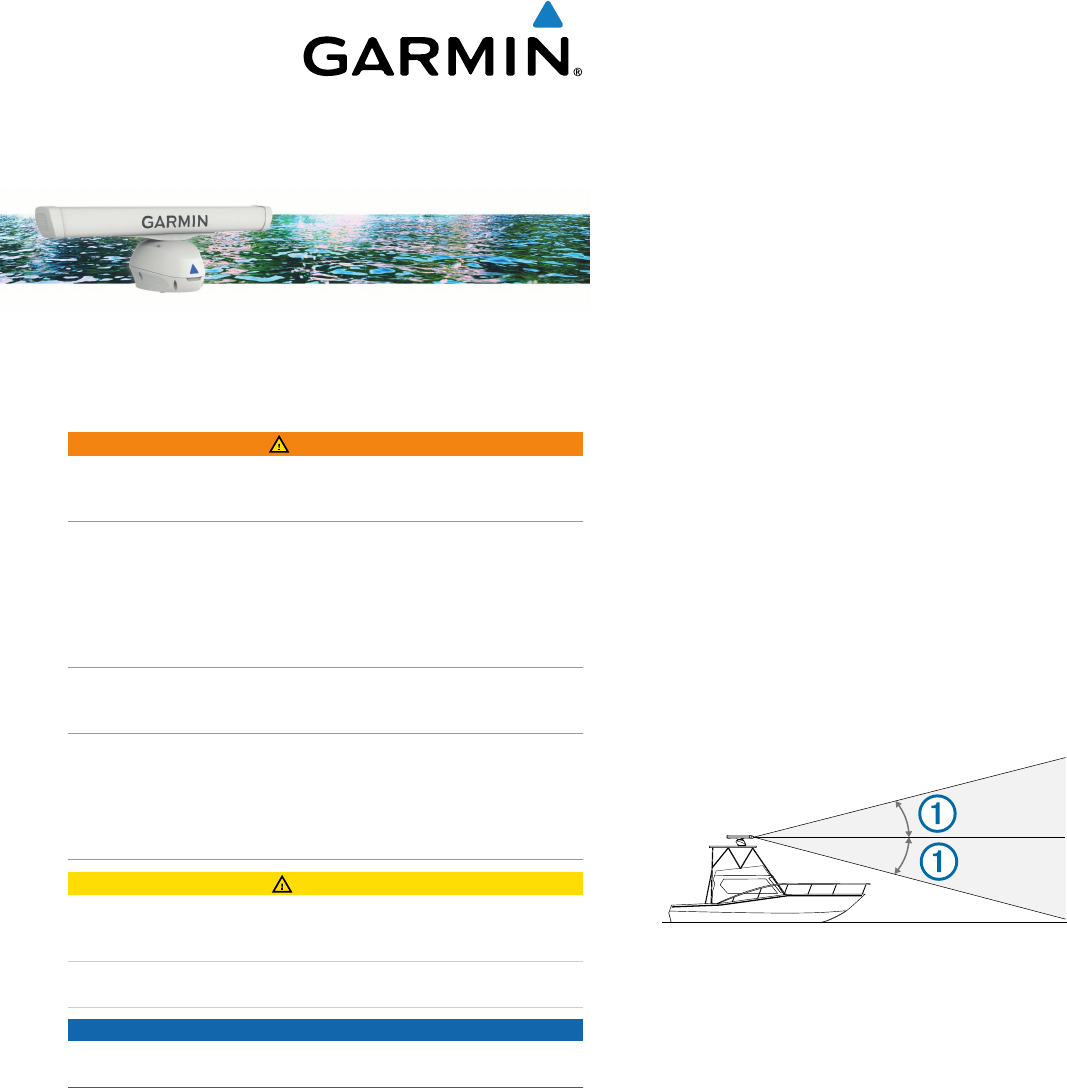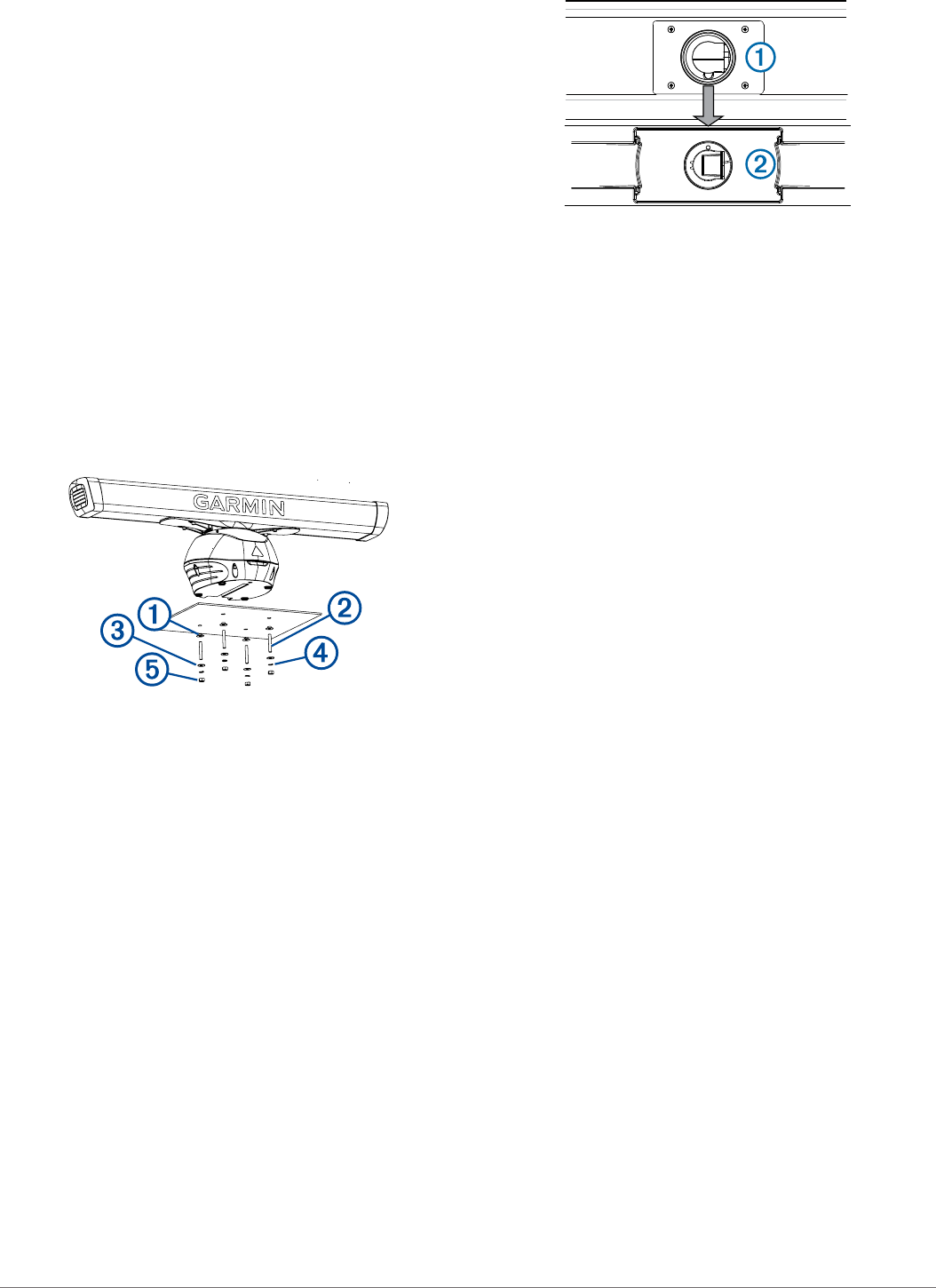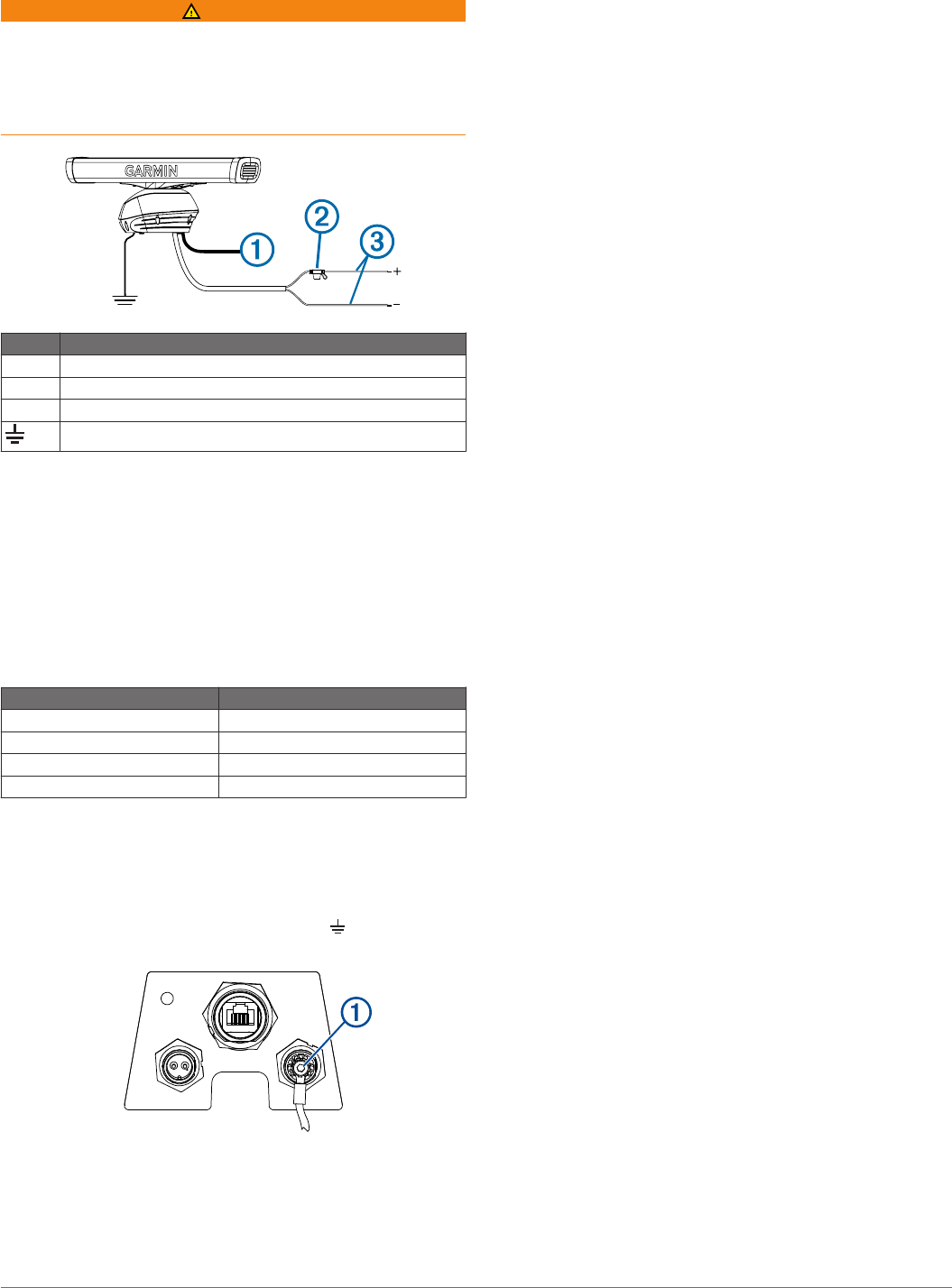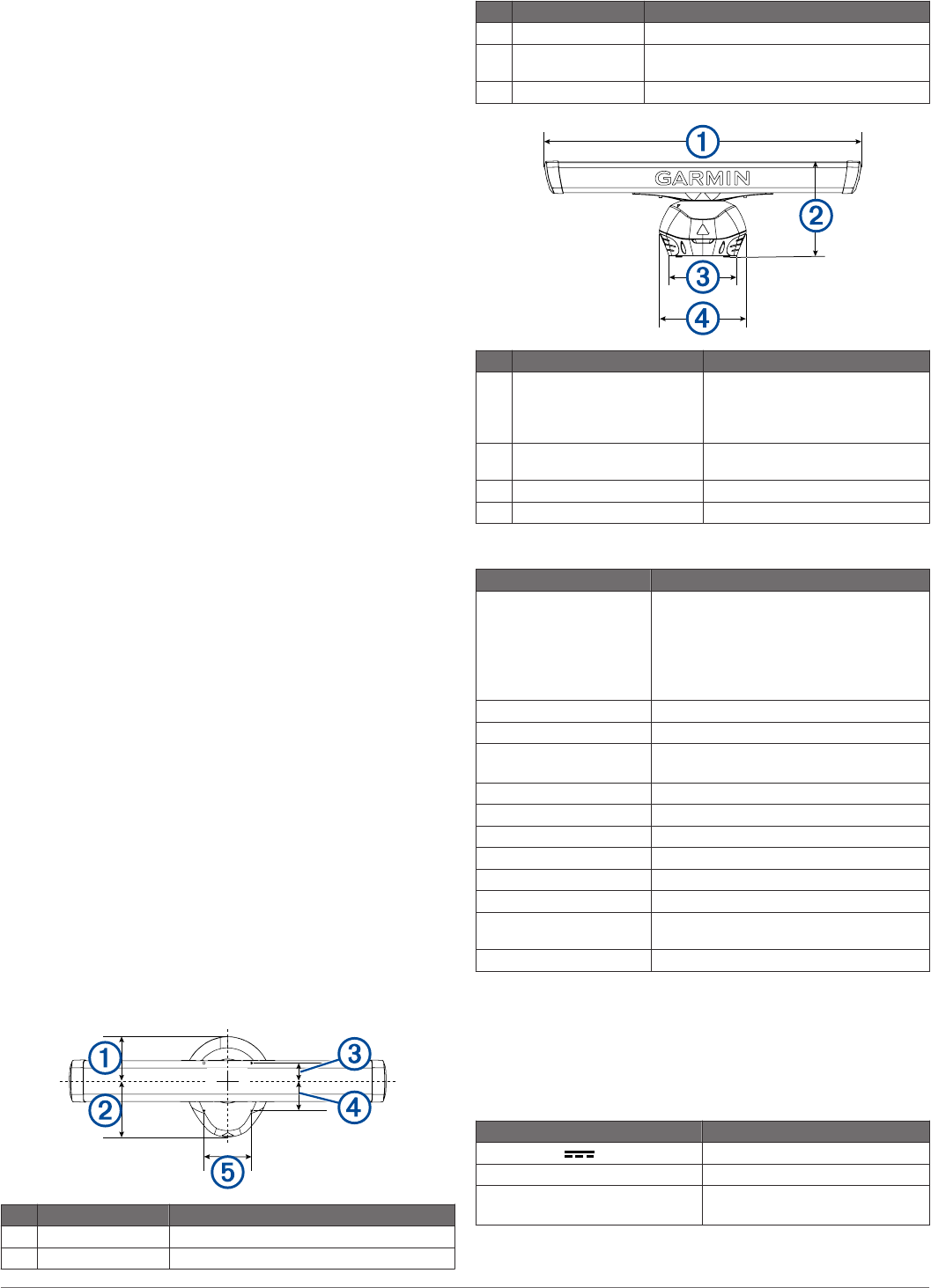Contents
- 1. Users Manual
- 2. Users Manual 1
Users Manual

GMR A02546 4/6
Installation Instructions
Important Safety Information
WARNING
See the Important Safety and Product Information guide in the
product box for product warnings and other important
information.
The radar transmits electromagnetic energy. Ensure that the
radar is installed according to the recommendations in these
instructions and that all personnel are clear of the path of the
radar beam before transmitting. When properly installed and
operated, the use of this radar conforms to the requirements of
ANSI/IEEE C95.1-1992 Standard for Safety Levels with Respect
to Human Exposure to Radio Frequency Electromagnetic Fields.
When the radar is transmitting, do not look directly at the
antenna at close range; eyes are the most sensitive part of the
body to electromagnetic energy.
When connecting the power cable, do not remove the in-line
fuse holder. To prevent the possibility of injury or product
damage caused by fire or overheating, the appropriate fuse
must be in place as indicated in the product specifications. In
addition, connecting the power cable without the appropriate
fuse in place voids the product warranty.
CAUTION
This device should be used only as a navigational aid. Do not
attempt to use the device for any purpose requiring precise
measurement of direction, distance, location, or topography.
Always wear safety goggles, ear protection, and a dust mask
when drilling, cutting, or sanding.
NOTICE
When drilling or cutting, always check what is on the opposite
side of the surface.
Registering Your Device
Help us better support you by completing our online registration
today.
• Go to my.garmin.com.
• Keep the original sales receipt, or a photocopy, in a safe
place.
Contacting Garmin® Product Support
• Go to www.garmin.com/support for in-country support
information.
• In the USA, call 913-397-8200 or 1-800-800-1020.
• In the UK, call 0808 238 0000.
• In Europe, call +44 (0) 870 850 1241.
Tools Needed
• #2 Phillips screwdriver
• 5 mm hex wrench
• Drill
• 15.0 mm (19/32 in.) drill bit
• 32 mm (1 1/4 in.) drill bit (optional)
• 17 mm (21/32 in.) wrench and torque wrench
• 3.31 mm² (12 AWG) copper wire to ground the radar housing
(the length depends on the distance from the radar to
ground)
• Marine sealant
Mounting Considerations
When selecting a mounting location, observe these
considerations.
• It is highly recommended that the device is mounted out of
range of people, with the vertical beam width above head
height. To avoid exposure to harmful radio frequency (RF)
levels, the device should not be mounted closer to people
than the maximum safe distance value listed in the product
specifications.
• The device should be mounted high above the ship’s keel
line with minimal blockage of the radar beam. Obstructions
may cause blind and shadow sectors, or generate false
echoes. The higher the installation position, the farther the
radar can detect targets.
• The device should be mounted on a flat surface or a platform
that is parallel to the vessel's water line and is sturdy enough
to support the device's weight. The weight for each model is
listed in the product specifications.
• The radar beam spreads vertically 11.5° above and
11.5° below À the radar's radiating element. On vessels with
higher bow angles at cruise speed, the installation angle can
be lowered to point the beam slightly downward to the
waterline while at rest. Shims can be used if necessary.
• The device should be mounted away from heat sources, such
as smoke stacks and lights.
• The device should be mounted at a different level than
horizontal spreaders and mast crosstrees.
• To avoid interference with a magnetic compass, the device
should not be mounted closer to a compass than the
compass-safe distance value listed in the product
specifications.
• Other electronics and cables should be mounted more than
2 m (6.5 ft.) from the radar beam path.
• GPS antennas should be either above or below the radar
beam path.
• The device should be mounted at least 1 m (40 in.) from any
transmitting equipment.
• The device should be mounted at least 1 m (40 in.) away
from cables carrying radio signals such as VHF radios,
cables, and antennas.
• The device should be mounted at least 2 m (6.5 ft.) away
from Single Side Band (SSB) radios.
February 2016 Printed in Taiwan 190-01967-91_01

Installation Procedures
Preparing the Radar Mounting Surface
Before you can mount the radar, you must choose a suitable
mounting location (Mounting Considerations, page 1).
1Secure the included mounting template to the surface at the
mounting location, along the bow-stern axis, as indicated on
the template.
2Drill the mounting holes using a 15 mm (19/32 in.) drill bit.
3If you need to run the power and network cables through the
mounting surface, select a location along the center channel
indicated on the template, drill a pass-through hole for the
cables using a 25 mm (1 in.) drill bit, and route the cables
through the surface (optional) (Cable Considerations,
page 2).
4Remove the mounting template from the surface.
Mounting the Radar
Before you can mount the radar, you must select a mounting
location (Mounting Considerations, page 1) and prepare the
mounting surface (Preparing the Radar Mounting Surface,
page 2).
1From under the mounting surface, place the included plastic
shoulder washers À into the holes you drilled when preparing
the mounting surface.
2Place the radar onto the mounting surface, aligning the holes
on the base of the radar with the holes in the shoulder
washers.
3Insert the threaded rods Á through the mounting surface and
into the radar base, and tighten them using a 5 mm hex
wrench.
To avoid damaging the pedestal, you should stop tightening
the threaded rods when they no longer turn easily.
4Place the flat washers Â, lock washers Ã, and hex nuts Ä on
the threaded rods.
5Tighten the hex nuts to a torque of 14.7 N-m (11 lbf-ft.) to
securely fasten the radar to the surface without damaging the
radar or the mounting hardware.
Installing the Antenna
Before you can install the antenna on the radar, you must
securely mount the pedestal (Mounting the Radar, page 2).
1Remove the protective cover from the waveguide on the top
of the pedestal À.
2Align the waveguide on the pedestal with the socket on the
bottom of the antenna Á, and slide the antenna onto the
pedestal.
3Secure the antenna to the pedestal by tightening the captive
hex bolts under the antenna arm.
4Tighten the hex bolts to a torque of 7.9 N-m (6 lbf-ft.) to
fasten the antenna to the pedestal without damaging the
antenna or the mounting hardware.
Cable Considerations
It may be necessary to drill 25 mm (1 in.) holes for routing the
power or network cables.
• When routing both the power and network cables through the
same hole, you must route the network cable before the
power cable.
• You must apply marine sealant to the hole after the cables
are in place to ensure a waterproof seal.
If the routing hole must be made in a visible location, decorative
cable grommets can be purchased from Garmin or a Garmin
dealer (optional).
• You must drill a 31.7 mm (11/4 in.) hole to use the optional
grommet.
• If needed, the grommet can be trimmed to enable you to
route both the network and the power cable through the
same hole.
• The optional grommet does NOT provide a waterproof seal.
You must apply marine sealant to the grommet after the
cables are in place ensure a waterproof seal.
When installing the network and power cables, you should
observe these considerations.
• Cutting the Garmin Marine Network cable is not
recommended, but a field install kit can be purchased from
Garmin or a Garmin dealer if cutting the network cable is
necessary.
• To ensure safety, appropriate tie-wraps, fasteners, and
sealant should be used to secure the cable along the route
and through any bulkheads or the deck.
• Cables should not be run near moving objects and high-heat
sources or through doorways and bilges.
• To avoid interference with other equipment, network and
power cables should not be run next to or parallel to other
cables, such as radio antenna lines or power cables. If this is
not possible, the cables should be shielded with metal
conduit or a form of EMI shielding.
• The power cable should be installed as close to the battery
source as possible.
◦ If it is necessary to extend the power cable, the
appropriate gauge of wire must be used (Power Cable
Extensions, page 3).
◦ Incorrectly extended runs of cable may cause the radar to
malfunction due to insufficient power transmission.
2

Connecting to Power
WARNING
When connecting the power cable, do not remove the in-line
fuse holder. To prevent the possibility of injury or product
damage caused by fire or overheating, the appropriate fuse
must be in place as indicated in the product specifications. In
addition, connecting the power cable without the appropriate
fuse in place voids the product warranty.
Item Description
ÀTo the Garmin Marine Network
Á15 A fuse holder
ÂTo the boat battery (from 10 to 32 Vdc)
Water ground connection
1Route the power cable to the radar and boat battery.
2Connect the power cable to the boat battery.
3Connect the power cable to the POWER port on the radar.
Power Cable Extensions
Connecting the power cable directly to the battery is
recommended. If it is necessary to extend the cable, the
appropriate gauge of wire must be used for the length of the
extension.
You must use crimp connectors and heat-shrink to create a
water-resistant connection.
Distance Wire Gauge
3 m (9 ft. 10 in.) 3.31 mm² (12 AWG)
5 m (16 ft. 4 in.) 5.26 mm² (10 AWG)
6.5 m (21 ft. 3 in.) 6.63 mm² (9 AWG)
8 m (26 ft. 2 in.) 8.36 mm² (8 AWG)
Grounding the Radar
The radar must be connected to the appropriate type of ground
using a 3.31 mm² (12 AWG) copper wire (not included).
1Route a 3.31 mm² (12 AWG) copper wire to a water ground
location and to the radar pedestal.
2Connect the wire to the ground connector ( ) on the
pedestal using the pre-installed crimp connector À.
3Coat the ground screw and crimp connector with marine
sealant.
4Connect the other end of the wire to the water ground
location on the boat, and coat the connection with marine
sealant.
Garmin Marine Network Considerations
This device connects to Garmin Marine Network devices to
share radar data with compatible devices on the network. When
connecting to a Garmin Marine Network device, observe these
considerations.
• A Garmin Marine Network cable must be used for all Garmin
Marine Network connections.
◦ Third-party CAT5 cable and RJ45 connectors must not be
used for Garmin Marine Network connections.
◦ Additional Garmin Marine Network cables and connectors
are available from your Garmin dealer.
• Although it is not recommended, you can use a field-
installable connector to create a custom-length Garmin
Marine Network cable if necessary. Follow the directions
provided with the connector.
Radar Operation
All functions of this radar are controlled with your Garmin
chartplotter. See the Radar section of your chartplotter's manual
for operating instructions. To download the latest manual, go to
www.garmin.com/support/.
Software Update
You may need to update the device software when you install
the device or add an accessory to the device.
The software update requires either a Garmin memory card
reader accessory or another Garmin chartplotter connected over
the Garmin Marine Network.
Loading the New Software on a Memory Card
The device may contain a software-update memory card. If so,
follow the instructions provided with the card. If a software
update memory card is not included, you must copy the software
update to a memory card.
1Insert a memory card into the card slot on the computer.
2Go to www.garmin.com/support/software/marine.html.
3Select Download next to “Garmin Marine Network with SD
card.”
4Read and agree to the terms.
5Select Download.
6Select Run.
7Select the drive associated with the memory card, and select
Next > Finish.
Updating the Device Software
Before you can update the software, you must obtain a
software-update memory card or load the latest software onto a
memory card.
1Turn on the chartplotter.
2After the home screen appears, insert the memory card into
the card slot.
NOTE: In order for the software update instructions to
appear, the device must be fully booted before the card is
inserted.
3Follow the on-screen instructions.
4Wait several minutes while the software update process
completes.
5When prompted, leave the memory card in place and restart
the chartplotter manually.
6Remove the memory card.
NOTE: If the memory card is removed before the device
restarts fully, the software update is not complete.
Specifying the Antenna Size
Before you can use the radar on your system, you must specify
the antenna size.
3

You must mount the radar, connect it to power, and connect it to
the Garmin Marine Network before you can specify the antenna
size.
1Turn on the radar and all devices connected to the Garmin
Marine Network.
An antenna-selection prompt appears on the connected
chartplotters.
NOTE: If the entire system is being turned on for the first
time, the antenna-selection screen is part of the initial setup
process.
2Select the installed antenna size for each open-array radar
installed on the boat.
TIP: If you need to specify a different antenna size, while
viewing the radar screen for the radar you want to change ,
select Menu > Radar Setup > Installation > Antenna
Configuration > Antenna Size, and select the antenna size.
Front-of-Boat Offset
The front-of-boat offset compensates for the physical location of
the radar scanner on a boat, if the radar scanner does not align
with the bow-stern axis.
Measuring the Potential Front-of-Boat Offset
The front-of-boat offset compensates for the physical location of
the radar scanner on a boat, if the radar scanner does not align
with the bow-stern axis.
1Using a magnetic compass, take an optical bearing of a
stationary target located within viewable range.
2Measure the target bearing on the radar.
3If the bearing deviation is more than +/- 1°, set the front-of-
boat offset.
Setting the Front-of-Boat Offset
Before you can set the front-of-boat offset, you must measure
the potential front-of-boat offset.
The front-of-boat offset setting configured for use in one radar
mode is applied to every other radar mode and to the Radar
overlay.
1From a Radar screen or the Radar overlay, select Menu >
Radar Setup > Installation > Front of Boat.
2Select Up or Down to adjust the offset.
Setting a Custom Park Position
If you have more than one radar on your boat, you must be
viewing the radar screen for the radar you want to adjust.
By default, the antenna is stopped perpendicular to the pedestal
when it is not spinning. You can adjust this position.
1From the radar screen, select Menu > Radar Setup >
Installation > Antenna Configuration > Park Position.
2Use the slider bar to adjust the position of the antenna when
stopped, and select Back.
Specifications
Dimensions
Item Measurement Description
À185.9 mm (75/16 in.) Center of rotation to the rear of the pedestal
Á234.7 mm (91/4 in.) Center of rotation to the front of the pedestal
Item Measurement Description
Â86 mm (325/64 in.) Center of rotation to the rear mounting holes
Ã114 mm (41/2 in.) Center of rotation to the front mounting
holes
Ä200 mm (77/8 in.) Distance between the mounting holes
Item Measurement Description
À4 ft. models: 132.8 cm (4 ft.
45/16 in.)
6 ft. models: 193.8 cm (6 ft.
45/16 in.)
Antenna length
Á40.3 cm (157/8 in.) Base of the pedestal to the top of
the antenna
Â28.6 cm (111/4 in.) Width of the pedestal at the base
Ã36.4 cm (145/16 in.) Width of the pedestal in the center
Physical Specifications
Specification Measurement
Minimum safe operating
distance*
4 ft. antenna
• 10 W/m2: 1.26 m (49.5 in.)
• 100 W/m2: 3.99 m (157 in.)
6 ft. antenna
• 10 W/m2: 1.59 m (61 in.)
• 100 W/m2: 5.03 m (198 in.)
Compass-safe distance 305 mm (12 in.)
Pedestal weight 15.7 kg (34.7 lb.)
Antenna weight 4 ft. antenna: 5.2 kg (11.4 lb.)
6 ft. antenna: 7.3 kg (16.0 lb.)
Power cable length 15 m (49 ft. 3 in.)
Network cable length 15 m (49 ft. 3 in.)
Antenna rotation speed 24 rpm and 48 rpm
Maximum wind load 80 kn
Temperature range From -15 to 55ºC (from 5 to 131ºF)
Humidity 95% at 35°C (95°F)
Water resistance IEC 60529 IPX6 (protected against heavy
seas)
Bearing accuracy 0.25 degrees
*When it is transmitting, the radar should be located in a position
on the vessel that is at least this far from people.
IEC 60936-1, clause 3-27.1, specifies the maximum distances
from the antenna at which radio frequency (RF) levels can be
expected.
Electrical Specifications
Specification Measurement
Input voltage From 10 to 32 Vdc
Fuse 15 A, blade-type
Input power Typical: 55 W
Maximum: 160 W
4

Antenna Specifications
Specification Measurement
Type End-fed slotted waveguide
Horizontal beam width 4 ft. antenna: 1.8 degrees
6 ft. antenna: 1.25 degrees
Horizontal side lobes -23 dB within ±10 degrees of main
-30 dB outside ±10 degrees of main
Vertical beam width 22 degrees
Polarization Horizontal
Installation Troubleshooting
Symptom Possible Causes
The radar does
not turn on. The
status LED is not
on.
• The power cable may not be connected correctly
to the device or to the battery. Check all
connections.
• The inline fuse may have blown. Check the fuse
and replace it if necessary.
• The wire gauge used to extend the power cable
may be too small for the length of the extension.
Check the table provided in the Power Cable
Extensions section of these instructions to make
sure the correct wire gauge is used (Power
Cable Extensions, page 3).
The radar is not
available on the
Garmin device or
on devices
connected to the
Garmin Marine
Network.
• The radar may not be powering on. Check the
status LED.
• The device software may not be up-to-date.
Update the software on the device or on the
Garmin Marine Network.
• The network cable may not be connected
correctly to the device or to the Garmin Marine
Network. Check all connections.
• If a field-installable network connector was used,
it may have been installed improperly. Check the
connector.
The status LED is located on the product label, and can help
troubleshoot installation problems.
Status LED Color
and Activity
Radar Status
Solid red The radar is getting ready for use. The LED
should be solid red briefly and change to flashing
green.
Flashing green The radar is operating properly.
Flashing orange The radar software is being updated.
Flashing red The radar has encountered an error. Contact
Garmin product support for assistance.
Garmin® and the Garmin logo are trademarks of Garmin Ltd. or its subsidiaries,
registered in the USA and other countries. GMR™ and A02546 are trademarks of Garmin
Ltd. or its subsidiaries. These trademarks may not be used without the express
permission of Garmin.
5

© 2016 Garmin Ltd. or its subsidiaries www.garmin.com/support